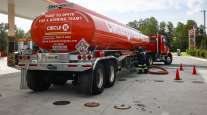Fuel Standard Should Weigh Freight Efficiency, NAS Says
By Sean McNally, Senior Reporter
This story appears in the April 5 print edition of Transport Topics.
A federal fuel standard for heavy trucks should take into account freight efficiency rather than simply setting a miles-per-gallon standard, as the government does for passenger cars and light trucks, the National Academy of Sciences said last week.
Regulators should consider alternative fuel-economy measures such as gallons per ton-mile, NAS said.
The NAS report also said that large trucks’ fuel use could be cut 51% by the end of the decade through various improvements. It recommended improving freight efficiency by allowing larger, heavier trucks on the nation’s highways.
The NAS report, which Congress requested in 2007 energy legislation, is the first step toward a fuel standard for trucks that the National Highway Traffic Safety Administration is expected to issue in 2012.
When the Department of Transportation sets truck fuel consumption standards, “it will have to address the duty cycles that characterize different types of vehicles and their wide range of applications,” the NAS report said.
The advisory group said that miles per gallon “is not the appropriate measure” for medium- and heavy-duty vehicles, but added that NHTSA should set “load-specific fuel consumption” standards. It noted that “a partially loaded tractor-trailer would consume less fuel per mile than a fully loaded truck, but this would not be an accurate measure of the fuel efficiency of moving goods.”
Besides regulations, the government could improve trucking fuel efficiency by raising fuel taxes, which the organization said it “strongly recommends,” and by allowing larger, heavier trucks, which it said “offers potentially significant fuel savings for the entire tractor-trailer combination truck fleet.”
The NAS report also recommended a cap-and-trade system to cut emissions and driver training, which “could be one of the most cost-effective and best ways to reduce fuel consumption and improve productivity of the trucking sector.”
Andrew Brown Jr., chairman of the NAS committee that wrote the report, said “the choices that will be made over the course of the next few years will establish the regulatory design for medium- and heavy-duty vehicle fuel-consumption standards for the next several decades.” Brown is executive director and chief technologist at Delphi Corp.
“There’s going to be changes in operations,” committee member Duke Drinkard said. Drinkard, an energy consultant with Southeastern Freight Lines, added that “the real trick is going to be to stay profitable while using equipment more wisely and making sure that the drivers are fully knowledgeable about the technology.”
NHTSA stated it was reviewing the report and that it will be “a valuable tool which will be used to inform our medium- and heavy-duty vehicle fuel-efficiency rulemaking.”
Industry officials welcomed the report’s findings, because it bolstered their arguments that setting automobile-style mileage standards for trucks is infeasible and it set a path to achieving significant fuel-consumption reductions for trucking.
Glen Kedzie, environmental counsel for American Trucking Associations, said ATA was “very encouraged” by the report. “It is reassuring to note that the NAS report realizes there is not a one-size-fits-all solution.”
David Nguyen, an automotive engineer with ATA, called the report “a relief.”
“A lot of what we’ve been discussing as an industry, not just with the regulators but within our own membership, shows we’re on a similar wavelength,” Nguyen said.
The Engine Manufacturers Association and Truck Manufacturers Association said in a joint statement they were “pleased” that the NAS report “takes into account the highly complicated nature of the commercial trucking industry and acknowledges that commercial trucking performs a function essential to the nation’s economy.”
The manufacturers said the report “recognizes that any measure of a commercial vehicle’s fuel consumption must reflect the work performed.”
With a combination of improvements to diesel engines, aerodynamic design changes to both trucks and trailers, lower vehicles weight, low-rolling-resistance tires, hybrid technology, the report stated that by 2015-2020, large trucks could improve efficiency by 51% over 2008 mileage.
Those improvements would add $84,600 to the cost of a truck, the report said, but would help a fleet’s bottom line over the long term. If fuel remained over $1.10 a gallon, the added cost would be made up over 10 years, a longer term than most fleets retain a truck, but the report said that the reduction in fuel use also carries “societal benefits” beyond the purchasers’ costs.
Drinkard said that, while he would be “shocked if any companies can actually achieve the maximum goal,” the 51% target is achievable.
“Can a fleet actually put that much [technology] on and get a payback in reasonable amount of time? Probably not, but there is a lot of gain to be made,” he said. “Some of these technologies will take 10 to 12 years to pay for themselves, while others are almost immediate, and fleets should go ahead and pick the low-hanging fruit because this is like pennies from heaven.”
“If you look at the smorgasbord of options set out in the NAS report, many technologies are currently available to reduce fuel consumption . . . [such as] improved aerodynamics, fuel-efficient tires, idle-reduction equipment, use of auxiliary power systems, weight reduction and intelligent vehicles,” Kedzie said.
“It would be a logical progression for NHTSA to focus initially on known technologies and then concentrate on other promising technologies such as hybridization, waste-heat recapture and improved engine efficiencies in the longer term,” he added.




